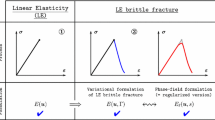Abstract
A model of creep-induced fracture in the three-dimensional stress state is developed on the basis of analysis of the initiation and growth of pores caused by plastic deformation and the diffusion of vacancies; calculations of the critical strain and longevity of specimens in the uniaxial and three-dimensional stress states are performed using this model. Comparison of the results with experimental data illustrates their satisfactory correspondence.
Similar content being viewed by others
Literature cited
L. M. Kachanov, Creep Theory [in Russian], Fizmatgiz, Moscow (1960).
Yu. N. Rabotnov, Creep of Structural Components [in Russian], Nauka, Moscow (1966).
J. Boyle and J. Spence, Analysis of Creep-Induced Stress in Structures [Russian translation], Mir, Moscow (1986).
D. M. Parks, “Mechanics and mechanisms of creep deformation and damage,” Nucl. Eng. Des.,105, 11–18 (1987).
A. A. Chizhik and Yu. K. Petrenya, “On the kinetic equations of damage sustained in evaluating the remaining life and reliability of materials under creep,” Tr. Tsentr. Nauchn.-Issled. Proekt.-Konstr. Kotloturb. Inst.,194, 27–37 (1982).
A. A. Chizhik and Yu. K. Petrenya, “Creep-induced fracture and microfracture mechanisms,” Dokl. Akad. Nauk SSSR,297, no. 6, 1313–1333 (1987).
I. W. Chen and A. S. Argon, “Diffusive growth of grain-boundary cavities,” Acta Met.,29, 1759–1768 (1981).
A. Needleman and I. R. Rice, “Plastic creep flow effect in the diffusive cavitation of grain boundaries,” Acta Met.,28, 1315–1332 (1980).
D. Hull and D. E. Rimmer, “The growth of grain-boundary voids under stress,” Phil. Mag.,4, 673–680 (1959).
M. V. Speight and W. Beere, “Creep cavitation by vacancy diffusion in plastically deforming solids,” Met. Sci.,21, 172–176 (1978).
I. W. Hancock, “Creep cavitation without a vacancy flux,” Met. Sci.,10, 310–325 (1976).
F. C. Monkman and N. I. Grant, “An empirical relationship between rupture life and minimum creep rate in creep-rupture tests,” Proc. Am. Soc. Test. Mater.,56, 593–597 (1956).
V. Dalya and V. Anton (eds.), Static Strength and Fracture Mechanics [in Russian], Metallurgiya, Moscow (1986).
I. Chadek, Creep of Metallic Materials [Russian translation], Mir, Moscow (1987).
I. W. Chen and A. S. Argon, “Creep cavitation in 304 stainless steel,” Acta Met.,29, 1031–1033 (1981).
B. I. Cane, “Deformation-induced intergranular creep cavitation in α-iron,” Met. Sci.,12, 102–108 (1978).
N. M. Malinin, Applied Theory of Plasticity and Creep [in Russian], Mashinostroenie, Moscow (1975).
V. P. D'yakonov, Handbook on Basic-Language Algorithms and Programs for Personal Computers [in Russian], Nauka, Moscow (1987).
G. P. Karzov, O. V. Kuklina, and B. Z. Margolin, “Some physicomechanical approaches to analysis of macroscopic fracture criteria. Report 2. Ductile failure,” Probl. Prochn., No. 8, 3–10 (1989).
Kontesti, Kaieto, and Levaiyan, “Metallographic investigation and numeric modeling of the process of creep-induced damage accumulation in notched specimens formed from stainless steel grade 17-12SPH,” Teor. Osnovy Inzh. Raschetov, No. 1, 150–162 (1988).
Author information
Authors and Affiliations
Additional information
Translated from Problemy Prochnosti, No. 10, pp. 23–29, October, 1990.
Rights and permissions
About this article
Cite this article
Kuklina, O.V., Margolin, B.Z. Physicomechanical model of creep-induced fracture. Strength Mater 22, 1409–1418 (1990). https://doi.org/10.1007/BF00767221
Received:
Issue Date:
DOI: https://doi.org/10.1007/BF00767221




